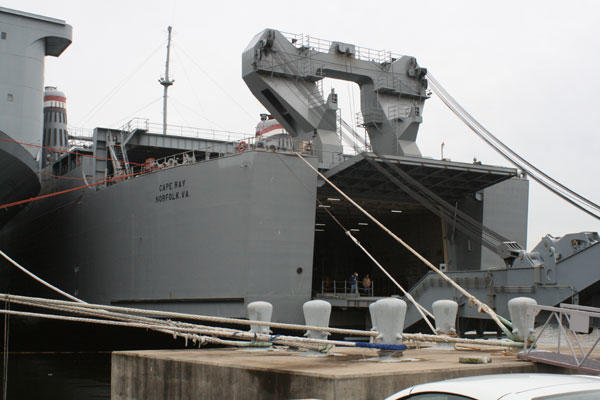PORTSMOUTH, Va. -- The U.S. Defense Department is preparing to send a specially outfitted ship to the Mediterranean Sea to destroy Syria's stockpiles of chemical weapons, a top official said here Thursday.
The MV Cape Ray will leave for the region within two weeks from a commercial shipyard here, according to Frank Kendall, the Pentagon's top weapons buyer. The 648-foot-long vessel has been outfitted with a pair of hydrolysis systems capable of dismantling 700 metric tons of the dangerous materials -- including mustard gas -- over three months, he said.
The ship hasn't receive its orders yet, but the plan is for warships to escort it to an as-yet undetermined port in the Mediterranean, where it will receive chemicals collected from Syria by Danish and Norwegian vessels, Kendall said. The Cape Ray will then head back out to sea to begin the process of destroying the agents, he said.
"Exactly where and how that process will take place hasn't been finalized yet," Kendall said. When asked how confident he was that Syria would actually turn over the weapons to international handlers, he said: "That's a Syrian obligation. We expect them to fulfill their obligation."
Syria missed a Dec. 31 deadline to relinquish control of some of its most dangerous chemicals, including about 20 tons of mustard nerve agent, according to an article by RT, Russia's state-owned television network. A Norwegian frigate and Danish warship on Tuesday left the country's main port of Latakia without the materials after containers of them never turned up, according to the report.
Syria agreed to give up the weapons as part of an internationally brokered deal that prevented a U.S. military intervention in the country. More than 130,000 people have died in the three-year-old uprising against forces loyal to President Bashar Assad, according to a recent estimate from the U.K.-based Syrian Observatory for Human Rights, which tracks the death toll through a network of activists in the country.
At the invitation of the Pentagon, a few dozen reporters and photographers on Thursday toured the ship, which is based in Norfolk and was being prepared for deployment at General Dynamics Corp.'s NASSCO-Earl Shipyard in Portsmouth.
The U.S. began exploring ways to destroy Syria's chemical weapon stockpiles about a year ago, Kendall said. Installing the hydrolysis systems onto a ship "wasn't the first option that came to mind," he said, in part because the process can be slowed by bad weather and choppy water.
The Defense Department benefited from a "flexible funding" process that allowed it to quickly purchase three of the so-called field deployable hydrolysis systems, each of which costs about $5 million, Kendall said. The technology isn't new -- about a decade old -- but it's highly effective and proven, he said.
Adam Baker, a chemical engineer for the Army's Edgewood Chemical Biological Center at Aberdeen Proving Ground, Md., said the technology was tested over the past year using mustard gas and methylphosphonyl difluoride, or DF, a precursor to sarin gas. He said the systems aboard the Cape Ray could process and destroy Syria's entire stockpiles of those agents on a single trip.
"The ship's going to be packed," he said, noting that a deck below can fit 280 shipping containers holding 6,600 gallons of chemical material apiece. "It's going to be tight."
The process, which uses water and other reactants to neutralize chemical weapons, creates a large amount of hazardous waste -- potentially more than a dozen times the volume of the agent being treated, according to a Pentagon fact sheet. U.S. officials said the waste will be commercially disposed of, but didn't specify where.
Each system includes a hydrolysis unit and a titanium reactor tank, and is designed to run around-the-clock with a 15-person crew. Some 100 personnel will deploy with the Cape Ray, about two-thirds of whom are engineers and workers who will operate the equipment.
The ship itself isn't part of the Navy fleet. The 36-year-old vessel is maintained by the Transportation Department's Maritime Administration as part of the so-called Ready Reserve Force, a fleet of almost 50 commercial ships that can be activated to support emergencies.
The Cape Ray was built in 1977 by Kawasaki Heavy Industries and is managed by Keystone Shipping Service, according to a separate fact sheet.



























